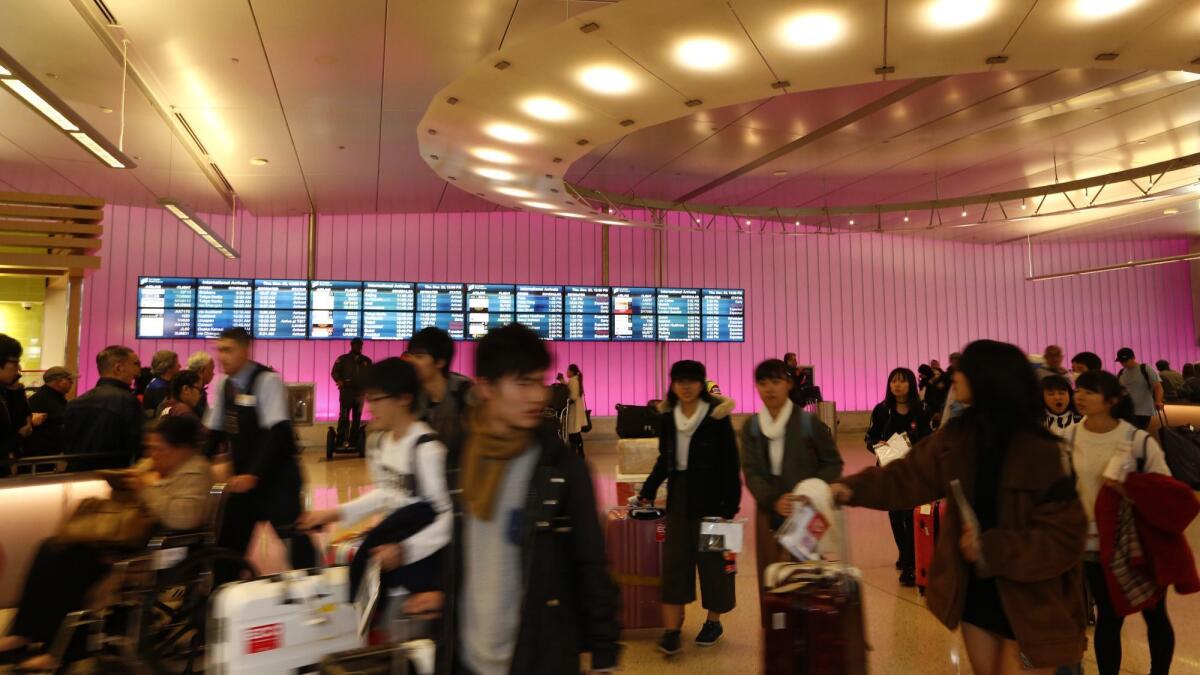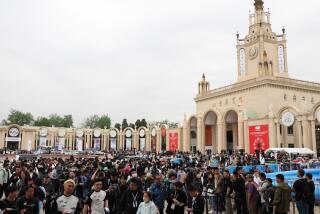China has a big weapon that it hasn’t used in the trade war yet: tourists

Fewer Chinese business executives, tourists and students are planning to visit the United States, a sign that the trade war between Washington and Beijing might spread in unpredictable and costly ways.
The nascent decline — visible in visa approvals and airline bookings — isn’t the result of official action by Beijing. But it highlights a potent weapon that China could use if the trade war persists: slashing the $60 billion that Chinese consumers spend each year on American services such as travel and tourism.
Already, 102,000 fewer Chinese people received business, leisure and educational visas from May through September of this year compared with the same period last year, a 13% drop, according to State Department statistics.
Chinese airline reservations to U.S. destinations dropped 42% for the first week of October, a national holiday that normally means increased outbound trips, according to Skyscanner, a search engine owned by China’s largest travel company.
Travel officials say they haven’t seen any evidence yet of a downturn in Chinese visitors. “But without question that is a source of a travel market that deserves the full attention of U.S. policymakers,” said Jonathan Grella, executive vice president of public affairs at the U.S. Travel Assn.
The industry group met last month with President Trump at the White House to share its concerns. “We run a $28-billion travel trade surplus with China, so if one of the results of prolonged trade tensions is a drop-off in Chinese visitation, it would have the ironic effect of taking our trade balance in the wrong direction,” Grella said.
Indeed, unlike merchandise trade, for which Trump often complains about the large deficit with China, the United States enjoys a sizable services surplus — making such commerce a large and potentially vulnerable target in a lengthy trade war. Since 2011, U.S. services trade with China has grown more than three times as fast as the shipments of goods that Trump usually focuses on.
“We have expected that they will try a whole range of things to encourage us to back down,” said a senior administration official, who requested anonymity to discuss internal deliberations. “It’s not going to work. But we would hope China wouldn’t do that.”
China’s done it before. During a diplomatic dispute with South Korea last year, the Chinese government banned the sale of package tours to Seoul and Jeju Island. The boycott cost South Korean businesses nearly $7 billion in just a few months, as Chinese tourists obeyed their government’s orders to head elsewhere.
Launching a similar boycott against the United States would risk alienating millions of middle-class Chinese who put a premium on American education and thirst for American vacations.
But a consumer embargo could deprive the U.S. travel industry of its most lucrative customers — Chinese tourists spend an average of $6,900 on each trip — and hurt American universities that have enjoyed a surge in enrollment by Chinese students. China last year sent more than 350,000 college students to the United States, almost twice as many as India, the No. 2 source.
If China chooses to widen the trade war by curbing its citizens’ spending on travel, financial services or consulting contracts, the United States would feel the effect more quickly than if Beijing levied additional tariffs on American goods, according to Joy Dantong Ma, a research associate at the Paulson Institute in Chicago.
Chinese manufacturers need time to rearrange complex supply chains, but Chinese consumers can easily change vacation plans to visit Tuscany rather than Napa Valley, she said.
Before Chinese leader Deng Xiaoping began opening the economy to foreign influence in the late 1970s, Chinese citizens who wanted to travel were required to obtain the permission of their work units and local police authorities. Tourist departures were minuscule.
But as China has grown more prosperous, the number of Chinese going abroad has soared. Nearly 3 million visitors arrived in the United States in 2016, the most recent annual data available, up from just 525,000 in 2009, according to the Commerce Department.
Chinese leaders may hesitate to boycott the United States, however, for fear of angering middle-class citizens who covet American diplomas for their children or just want to see Hollywood or Manhattan. In July, when a young man from Inner Mongolia detonated a small bomb near the U.S. Embassy in Beijing, people were back in the outdoor visa line less than an hour later, even as the bomber’s blood pooled on the sidewalk.
So far, the dispute between the world’s two largest economies has been confined to their $635 billion in annual goods trade. Trump has imposed tariffs on roughly half of what Americans buy from China every year, and China has retaliated with similar levies on most of its smaller volume of orders from the United States.
Because China buys far less from the United States than it sells to Americans, it can’t match Trump’s tariffs dollar for dollar. Chinese officials for now don’t appear eager to escalate the conflict, hoping that a negotiated outcome after the U.S. congressional elections remains possible.
But that could change if negotiations stall — and both sides appear to be digging in for a fight.
In Los Angeles, Chinese tourists’ most-visited U.S. destination, tourism officials are cautious about potential trade-war fallout. The city’s tourism board, which has offices in four Chinese cities, says the 1.2 million Chinese visitors expected this year are more than twice the number who came in 2013.
Along with seeing traditional attractions such as Universal Studios or a Los Angeles Lakers game, many Chinese tourists also shop for gifts to bring home, said Kathy Smits, vice president of the Los Angeles Tourism & Convention Board.
“We are absolutely keeping a close eye on it because it is a market that’s impacted by what destinations are looked upon favorably,” Smits said. “Just because we’re positive right now doesn’t mean there couldn’t be a change in the short term.”
Lynch writes for the Washington Post.
More to Read
Inside the business of entertainment
The Wide Shot brings you news, analysis and insights on everything from streaming wars to production — and what it all means for the future.
You may occasionally receive promotional content from the Los Angeles Times.









